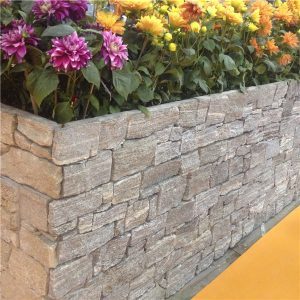Introduction
Cottage cultured stone, also known as manufactured stone veneer, has been gaining popularity in the construction and design industry for its versatility, durability, and aesthetic appeal. This synthetic stone material is designed to mimic the look and feel of natural stone, providing an affordable alternative for homeowners and builders looking to enhance the beauty and value of their properties. In this comprehensive guide, we will delve into the world of cottage cultured stone, exploring its history, manufacturing process, installation techniques, benefits, and design possibilities.
History of Cottage Cultured Stone
The concept of manufactured stone veneer dates back to the mid-20th century when builders sought a cost-effective solution to replicate the appearance of natural stone in construction projects. Early versions of cultured stone were created using a mixture of cement, aggregates, and iron oxide pigments to mimic the colors and textures of real stone. Over the years, advancements in technology and manufacturing processes have led to the development of more sophisticated and realistic cottage cultured stone products.
Manufacturing Process
Cottage cultured stone is typically made from a blend of Portland cement, lightweight aggregates, and iron oxide pigments to create a durable and realistic-looking material. The manufacturing process involves mixing these ingredients together with water to form a moldable slurry that is poured into molds designed to replicate the shape and texture of natural stone. Once the slurry has set and cured, the resulting stone veneer is removed from the molds and treated with a sealant to enhance its durability and weather resistance.
Installation Techniques
Installing cottage cultured stone requires careful planning and skill to ensure a professional finish that enhances the overall aesthetic of a building. The first step in the installation process is to prepare the surface by cleaning and priming it to ensure proper adhesion of the stone veneer. Next, the stones are laid out in a desired pattern, taking care to stagger the joints and maintain a consistent spacing between the stones. https://www.fs-slate.com/step-stone/ are then adhered to the surface using a mortar or adhesive, and grouted to fill in any gaps and create a seamless look.
Benefits of Cottage Cultured Stone
There are numerous benefits to using cottage cultured stone in construction and design projects. One of the primary advantages of manufactured stone veneer is its cost-effectiveness compared to natural stone, making it a more affordable option for homeowners and builders looking to achieve a high-end look without breaking the bank. Additionally, cottage cultured stone is lightweight and easy to handle, making it an ideal choice for DIY enthusiasts and professional installers alike. The material is also highly durable and weather-resistant, ensuring that it will maintain its appearance and structural integrity over time.
Design Possibilities
Cottage cultured stone offers virtually limitless design possibilities, allowing homeowners and designers to create custom looks that suit their personal style and aesthetic preferences. Whether you are looking to enhance the exterior of your home with a rustic stone facade or add a touch of elegance to your interior with a stone accent wall, cottage cultured stone can be used to achieve a wide range of design effects. The material is available in a variety of colors, textures, and shapes, making it easy to create unique and eye-catching features that will set your property apart.
Maintenance and Care
One of the key advantages of cottage cultured stone is its low maintenance requirements, making it an attractive option for homeowners looking to enhance the beauty of their properties without the need for frequent upkeep. To keep your stone veneer looking its best, it is recommended to regularly clean the surface with a mild detergent and water to remove dirt and debris. Additionally, applying a sealant every few years can help protect the stone from the elements and maintain its appearance over time.
Environmental Considerations
Cottage cultured stone is an environmentally friendly building material that offers several sustainability benefits compared to natural stone. The manufacturing process for cottage cultured stone produces less waste and consumes fewer resources than quarrying and processing natural stone, making it a more eco-friendly choice for environmentally conscious homeowners and builders. Additionally, the lightweight nature of cottage cultured stone reduces transportation costs and emissions, further minimizing its environmental impact.
Case Studies

To showcase the versatility and beauty of cottage cultured stone, let's explore a few real-world case studies where this material has been used to stunning effect:
1. Exterior Facade: A traditional cottage-style home was given a modern update with the addition of cottage cultured stone veneer on the exterior facade. The warm tones and rustic texture of the stone complemented the architectural style of the home, creating a welcoming and timeless look that enhanced its curb appeal.
2. Fireplace Surround: A contemporary living room was transformed with the installation of a cottage cultured stone fireplace surround. The sleek design and natural colors of the stone added a touch of sophistication to the space, creating a focal point that drew the eye and added depth and texture to the room.
3. Outdoor Kitchen: A backyard oasis was created with the addition of an outdoor kitchen featuring a cottage cultured stone countertop and backsplash. The durable and weather-resistant nature of the stone made it an ideal choice for the outdoor environment, while the earthy tones and organic texture added warmth and character to the space.
Conclusion
Cottage cultured stone offers a timeless and versatile solution for homeowners and builders looking to enhance the beauty and value of their properties. With its realistic appearance, durability, and cost-effectiveness, this synthetic stone material provides a practical and aesthetically pleasing alternative to natural stone. By exploring the history, manufacturing process, installation techniques, benefits, design possibilities, maintenance requirements, and environmental considerations of cottage cultured stone, you can gain a comprehensive understanding of this versatile building material and how it can be used to create stunning and enduring design features in any space.
